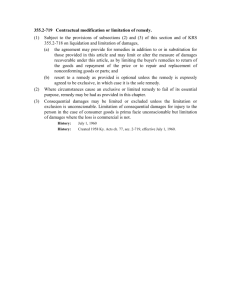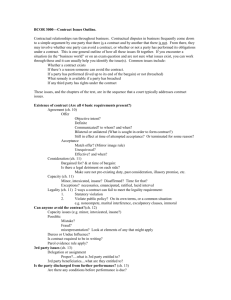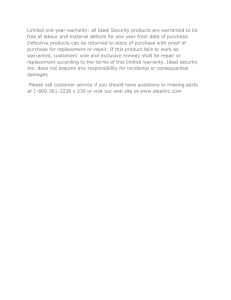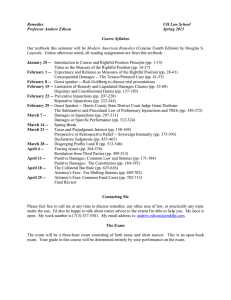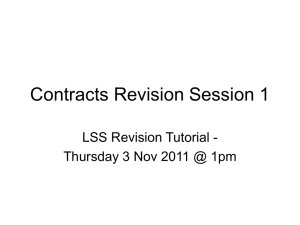Drafting Liability-Limiting Clauses
advertisement
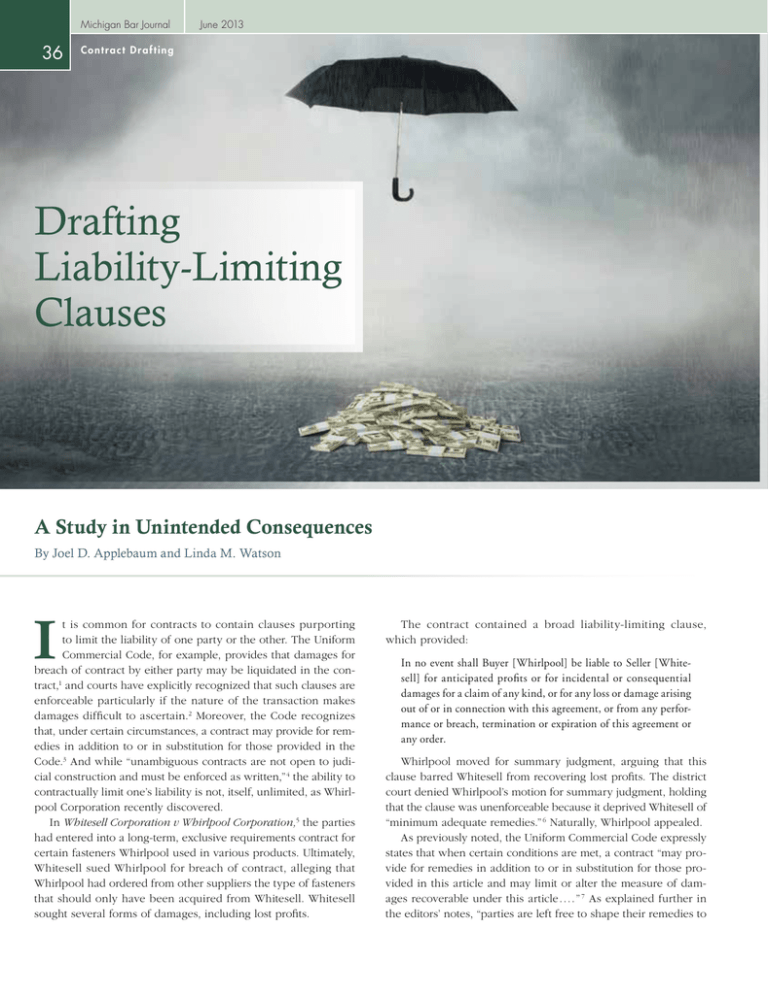
Michigan Bar Journal 36 June 2013 Contract Drafting Drafting Liability-Limiting Clauses A Study in Unintended Consequences By Joel D. Applebaum and Linda M. Watson I t is common for contracts to contain clauses purporting to limit the liability of one party or the other. The Uniform Commercial Code, for example, provides that damages for breach of contract by either party may be liquidated in the contract,1 and courts have explicitly recognized that such clauses are enforceable particularly if the nature of the transaction makes damages difficult to ascertain.2 Moreover, the Code recognizes that, under certain circumstances, a contract may provide for remedies in addition to or in substitution for those provided in the Code.3 And while “unambiguous contracts are not open to judicial construction and must be enforced as written,” 4 the ability to contractually limit one’s liability is not, itself, unlimited, as Whirlpool Corporation recently discovered. In Whitesell Corporation v Whirlpool Corporation,5 the parties had entered into a long-term, exclusive requirements contract for certain fasteners Whirlpool used in various products. Ultimately, Whitesell sued Whirlpool for breach of contract, alleging that Whirlpool had ordered from other suppliers the type of fasteners that should only have been acquired from Whitesell. Whitesell sought several forms of damages, including lost profits. The contract contained a broad liability-limiting clause, which provided: In no event shall Buyer [Whirlpool] be liable to Seller [Whitesell] for anticipated profits or for incidental or consequential damages for a claim of any kind, or for any loss or damage arising out of or in connection with this agreement, or from any performance or breach, termination or expiration of this agreement or any order. Whirlpool moved for summary judgment, arguing that this clause barred Whitesell from recovering lost profits. The district court denied Whirlpool’s motion for summary judgment, holding that the clause was unenforceable because it deprived Whitesell of “minimum adequate remedies.” 6 Naturally, Whirlpool appealed. As previously noted, the Uniform Commercial Code expressly states that when certain conditions are met, a contract “may provide for remedies in addition to or in substitution for those provided in this article and may limit or alter the measure of damages recoverable under this article. . . . ” 7 As explained further in the editors’ notes, “parties are left free to shape their remedies to June 2013 Michigan Bar Journal 37 Fast Facts While it is common for contracts governed by the Uniform Commercial Code to limit damages, careful thought must be given when drafting a liability-limiting clause. The ability to contractually limit one’s liability is not, itself, unlimited, as Whirlpool Corporation recently discovered in White­sell Corporation v Whirlpool Corporation. In drafting a liability-limiting clause, consider emphasizing that the contract is of a commercial nature among sophisticated business concerns and that both parties participated in the drafting and were represented by competent counsel. their particular requirements and reasonable agreements limiting or modifying remedies are to be given effect.”8 What is an example of an unreasonable agreement to limit or modify remedies? The notes provide some parameters to consider, such as requiring “minimum adequate remedies” or a “fair quantum of remedy.” More specifically, they state: [I]t is of the very essence of a sales contract that at least minimum adequate remedies be available. If the parties intend to conclude a contract for sale within this Article they must accept the legal consequence that there be at least a fair quantum of remedy for breach of the objections or duties outlined in the contract. Thus any clause purporting to modify or limit the remedial provisions of this Article in an unconscionable manner is subject to deletion and in that event the remedies made available by this Article are applicable as if the stricken clause had never existed.9 On appeal, Whirlpool argued that “the plain language of the clause only barred Whitesell from recovering anticipated profits, incidental damages, and consequential damages, but allowed Whitesell adequate remedies outside of these exclusions.”10 The Court of Appeals disagreed, finding that the language “In no event shall Buyer be liable to Seller .. .for any loss or damage arising out of or in connection with this agreement, or from any performance or breach . . . ” unambiguously deprived Whitesell of any form of damages resulting from Whirlpool’s failure to purchase. Thus, the Court concluded that, while reasonable agreements limiting or modifying remedies are to be given effect, here “the clause completely deprives Whitesell of any remedy; therefore, it cannot be considered reasonable.”11 The district court’s decision to strike the offending clause was affirmed and, because the Uni- form Commercial Code, like nature, abhors a vacuum, all rem­ edies made available by the Code rushed in to fill the void, including the right to recover lost profits and other incidental or consequential damages.12 One might be tempted to chalk up the Whirlpool decision to overreaching on Whirlpool’s part. In other words, rather than trying to contract away all remedies, Whirlpool should have been satisfied to leave Whitesell with the very least the law requires. Had Whirlpool done so, presumably the district court would have enforced a liability-limiting clause that excluded lost profits. But this presumption ignores the basic question: namely, what is the very least the law requires? Where does one draw the line between an enforceable and unenforceable liability-limiting clause? In an analogous context, Professors White and Summers refer to cases and Code commentary that are “full of weasel words,”13 an observation equally applicable to the limitation of damages language used in Section 2-719. Indeed, Section 2-719(1)(a) incorporates Section 2-718, which addresses liquidated damages. Section 2-718 specifically allows the contracting parties to fix damages “but only at an amount which is reasonable in the light of the anticipated or actual harm caused by the breach, the difficulties of proof of loss, and the inconvenience or nonfeasibility of otherwise obtaining an adequate remedy. A term fixing unreasonably large liquidated damages is void as a penalty.”14 Putting aside the most basic question of how one determines whether a particular amount is “reasonable” or “unreasonably large,” other difficulties exist, such as how to properly advise a client on whether “anticipated” harm will trump “actual” harm or vice versa—the very questions a negotiated liquidated damages clause was presumably intended to avoid. Similarly, what does it mean to say the ultimate reasonableness of the liquidated damages depends on the “inconvenience” of otherwise obtaining an adequate remedy? Michigan Bar Journal 38 June 2013 C o n t r a c t D r a f t i n g — Draf ting Liabilit y- Limiting Clauses Section 2-719 carries these same ambiguities forward and compounds them. Contracting parties are invited to add or subtract remedies, limit or alter the measure of damages, and limit or even exclude consequential damages entirely, but only if the contract provides the nonbreaching party with “at least minimum adequate remedies.”15 In light of the Whirlpool decision, we know that “minimum adequate remedies” means something more than no remedy whatsoever. But how much more? And if the phrase “minimum adequate remedies” is not sufficiently nebulous, the comment goes on to state that contracting parties “must accept the legal consequence that there be at least a fair quantum of remedy for breach of the obligations or duties outlined in the contract.”16 Is a “fair quantum of remedy” more, less, or the same as “minimum adequate remedies?” Does the word “fair” refer to equity and justice or quality or amount? While these questions may not be susceptible to easy, predictable answers, as discussed below, they may have an enormous impact on the contracting parties. Again, any clause violating these frighteningly vague terms is subject to deletion, and then the remedies available by Arti­ cle 2 are applicable as if the stricken clause had never existed. In considering how to draft appropriate language, what are some alternatives that might provide at least minimum adequate remedies? Section 2-719(1)(a) identifies two alternative remedies that, because they are specifically identified, presumably satisfy the “minimum adequate remedy” or “fair quantum of remedy” standard. The first alternative remedy is returning the goods and obtaining repayment of the purchase price. The second alternative remedy is having the nonconforming goods or parts repaired or replaced. Neither remedy seems particularly applicable to the Whitesell/Whirlpool contract dispute, where the alleged injury was Whirlpool’s purchase of goods from sources other than Whitesell. But even in situations where alternative remedies are included in the contract, it cannot safely be assumed that a court would uphold an exclusion of consequential or other significant damages such as lost profits. Section 2-719(2) specifically provides that “[w]here circumstances cause an exclusive or limited remedy to fail of its essential purpose, remedy may be had as provided in this act.”17 The editors’ notes then summarize that “where an What does it mean to say the ultimate reasonableness of the liquidated damages depends on the “inconvenience” of otherwise obtaining an adequate remedy? apparently fair and reasonable clause because of circumstances fails in its purpose or operates to deprive either party of the substantial value of the bargain, it must give way to the general remedy provisions in this Article.”18 Of course, one of the provisions in “this Article” is that the contracting parties may limit or exclude consequential damages. Courts considering the validity of an exclusion of consequential damages in the context of a remedy that has failed in its essential purpose have reached significantly different results. A substantial number of courts hold that there is an integral and interdependent relationship between the exclusion of consequential damages and, for example, the limited remedy of repair or replacement, such that the failure of the limited remedy necessarily causes the invalidation of the consequential damages exclusion.19 Michigan has adopted this view that liability-limiting clauses are integrated and interdependent and, therefore, despite the parties’ negotiated and agreed efforts to limit liability, all remedies available under the Code, including consequential damages, become available when the limited remedy fails of its essential purpose.20 In stark contrast, a significant number of courts have concluded that a clause excluding or limiting consequential damages must be viewed independently, and if a limited remedy of repair fails in its essential purpose, the consequential damages limi­tation is not automatically voided.21 The provisions are viewed independently, in part, because they are two discrete ways of attempting to limit recovery and the Code tests each by a different standard.22 As to having a different standard, “[t]he former survives unless it fails of its essential purpose, while the latter is valid unless it is unconscionable.”23 However, “[t]he repair remedy’s failure of essential purpose, while a discrete question, is not completely irrelevant to the issue of the conscionability of June 2013 Michigan Bar Journal 39 enforcing the consequential damages exclusion.”24 Indeed, there is a narrow exception to this independence where it would be unconscion­able for the buyer to retain the risk of consequential damages upon a failure of an exclusive repair remedy. More specifically, a court may disavow the independence if there was any great disparity in the parties’ bargaining power or sophistication, such as when the buyer is an “ordinary consumer being misled by a disclaimer in a ‘linguistic maze.’ ” 25 Finding none, the parties are then deemed competent to agree on the allocation of risk involved in their commercial transaction.26 Careful thought must be given when drafting liability-limiting clauses in agreements governed by the Code. While a party can never guarantee such clauses will be enforced, it can take steps to minimize its risk. First, it is advisable to check your jurisdiction and determine whether it views liability-limiting clauses as interdependent or independent. If independent, take the additional step of confirming in the agreement that both parties are sophisticated and competent to allocate risk, that both parties participated in drafting the agreement, and that the parties were represented by competent counsel. By emphasizing that the contract is of a commercial nature among sophisticated business concerns, you will have undercut any later claim that the contract is unconscionable. Second, the agreement should be drafted to ensure that, in the event of a breach, the nonbreaching party has at least a minimum adequate remedy. In this regard, it is essential to review the particular circumstances and factual background underlying the proposed contract in an effort to craft a fair quantum of remedy. Third, while the parties may elect to include a clause limiting or excluding consequential damages, the parties should also understand such clauses may not be enforced if the limited remedies are deemed to have failed of their essential purpose. n Even in situations where alternative remedies are included in the contract, it cannot safely be assumed that a court would uphold an exclusion of consequential or other significant damages such as lost profits. Joel D. Applebaum is a member of Clark Hill’s Corporate Restructuring and Bankruptcy Practice Group, concentrating his practice in the areas of bankruptcy and corporate reorganization, creditors’ rights, bankruptcy-related litigation and appeals, and general commercial law. Linda M. Watson is a partner at Clark Hill, PLC. She has been listed as a Super Lawyer in business litigation. Her practice focuses on complex business advice and litigation on various subject matters including shareholder and owner disputes, corporate mergers and acquisitions, fraud and business torts, ERISA, trade secrets, intellectual property, noncompetes, franchise disputes, automotive disputes (OEM, Tier 1 and Tier 2 supplier), and general contract disputes. ENDNOTES 1.MCL 440.2718. 2.See Pichey v Ameritech Interactive Media Services, Inc, 421 F Supp 2d 1038, 1044 (WD Mich, 2006). 3.MCL 440.2719. 4.Pichey, n 2 supra, quoting Rory v Continental Ins Co, 473 Mich 457; 703 NW2d 23, 30 (2005). 5.Whitesell Corporation v Whirlpool Corporation, 496 Fed Appx 551 (CA 6, 2012). 6.Id. at 554. 7.MCL 440.2719(1)(a). 8.MCL 440.2719, Editors’ Notes. 9.Id. 10. Whitesell, n 5 supra at 554. 11. Id. at 555. 12. See generally MCL 440.2719. 13. White & Summers, Uniform Commercial Code (2d ed), p 127. 14. MCL 440.2718(1). 15. MCL 440.2719, Editors’ Notes. 16. Id. (emphasis added). 17. MCL 440.2719(2). For example, when an automobile is destroyed by a fire caused by a defective part after a dealership fails to correct the defect, the essential purpose of the dealership’s “repair and replace” remedy has failed. See Rudd Constr Co, Inc v Clark Equip Co, 735 F2d 974 (CA 6, 1984). 18. MCL 440.2719, Editors’ Notes. 19. See, e.g., Koehring Co v API Inc, 369 F Supp 882 (ED Mich, 1974); Kelynack v Yamaha Motor Corp, 152 Mich App 105; 394 NW2d 17 (1986). 20. The Kelynack v Yamaha Motor Corp decision involved a consumer contract for the purchase of a motorcycle, and, although not specifically stated, consumer protection, which is a strong policy embedded in Section 2-719, may have informed the court’s decision. 21. See, e.g., Piper Jaffray & Co v SunGard Systems Int’l, Inc, 57 UCC Rep Serv 2d 479 (D Minn, 2005). 22. Chatlos Sys, Inc v Nat’l Cash Register Corp, 635 F2d 1081, 1086 (CA 3, 1980). 23. Id. 24. Id. at 1086–1087. 25. Id. at 1087. 26. Id.
